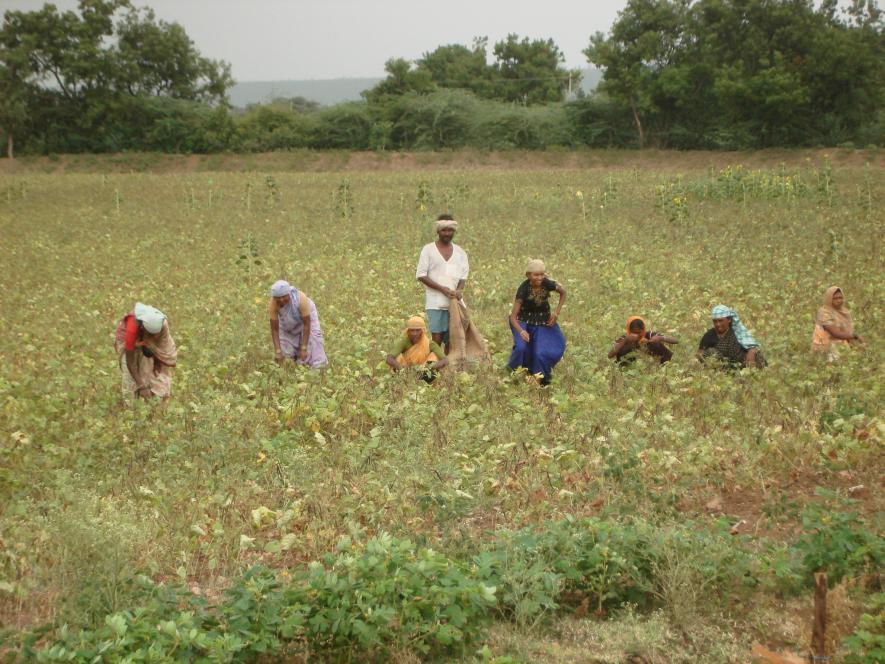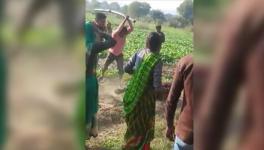Vicious Cycle of Perpetual Indebtedness Among Madhya Pradesh Farmers

Sitting in a camp at the Palwal border, Shrikrishna Kushwaha shares an old proverb – “Uttam kheti madhyam baan, neech chakari bheekh nidan”. “In the past, agriculture was considered to be the most honorable source of livelihood followed by business activities. Salaried job was placed at the bottom and was compared to begging,” he explains and adds that now this has been reversed. “Now, the MLAs and MPs who come to beg for our votes are billionaires today. Civil servants and businessmen are also much more powerful than farmers,” says Kushwaha (65), a semi-medium farmer with six acres of land in Morena district in Madhya Pradesh.
Kushwaha laments that farmers today find themselves in a condition where it has become difficult to even survive. He says, “I have 10 bigha (6 acres) of land. From that, we are merely able to afford food for survival – mustard seeds for oil, wheat for food grains. The rest of the produce is sold and even that is not enough to make our ends meet because we do not get adequate returns for our produce.”
“The cost of cultivation is very high. This includes costs incurred on ploughing, sowing, fertilisers, seeds and hiring tractors and agricultural labour. It is for this reason that our sons have to go out to seek other sources of livelihood for us to be able to afford education for children, household expenditure and other expenses such as that on marriages. Our agricultural incomes cannot provide for our day-to-day expenses, medical expenses or our consumption expenditure. Even as an owner of six acres of land, I do not make any profits at all,” adds Kushwaha.
Kushwaha had borrowed Rs 2 lakh from a money-lender from his village two years ago at an interest rate of 2% per month or 24% per annum. Repayment has been difficult and they have been forced to sell off two buffaloes to pay the interest, he says. The loan remains unpaid. There was a bank loan as well of Rs. 80,000 that he had taken 10 years ago. On this loan, he had paid a total interest of Rs. 1,24,000 until the loan was waived in 2018 when the government of Madhya Pradesh introduced a loan waiver scheme.
Also read: Strengthening the MSP System
Explaining his indebtedness, Padam Singh Meena from village Thua Kheda in Bhopal, asks, “How do we run our families when we do not get returns for our agricultural produce?” He adds, “All the income is spent on weddings and education. We are becoming indebted. Ultimately, we will have to sell our land. We had not been able to pay the interest last year. Even this year, we have not paid the interest. How do we manage? The cost of cultivation is very high and the produce from the land is not enough.”
Meena, along with his brothers Kartar Singh and Vimal Singh, own 23 acres of land in Thua Kheda, Bhopal and 21 acres of land in Gehun Kheda in Madhya Pradesh. For the family of around 30 members, they had taken a loan of Rs 9 lakh 15 years ago mortgaging their land at Thua Kheda from Punjab Bank (then Oriental bank) at an interest rate of 12% per annum. They had taken this loan on a Kisan Credit Card for agricultural purposes. The family had also borrowed a sum of Rs 9 lakh mortgaging their land at Gehun Kheda six years ago. The interest rate on this loan was 12% as well. Low returns on the produce meant that they were unable to pay the interest on both the loans this year.
Farmers from Thua Kheda claimed, while speaking to NewsClick, that a total of 20 houses in their village have accumulated a debt of about Rs 2 crore over the past 30 years. All India Kisan Sabha (AIKS) Joint Secretary Badal Saroj concurs and says that this is the condition of almost all the villages in Madhya Pradesh.
As reported earlier, the actual cost of cultivation (CoC) incurred by small farmers in Madhya Pradesh for wheat is far greater than the CoC projected by the Central government’s Commission of Agricultural Costs and Prices (CACP) in its Price Policy Report (2021-22). The CoC estimates projected by CACP form the basis on which Minimum Support Price (MSP) is declared. This report also calculated the estimates of losses that small farmers in different regions of Madhya Pradesh suffer. Low returns for their produce have been a major factor pushing farmers into economic distress and indebtedness.
According to the All India Rusral Financial Inclusion Survey 2016-17 by NABARD, incidence of indebtedness in Madhya Pradesh was found to be 43% among all households. All India indebtedness was found to be 47.4%, where indebtedness among agricultural households was 52.5% as opposed to 42.8% in non-agricultural households. Incidence of indebtedness was highest in Telangana (79%), Andhra Pradesh (77%), and Karnataka (74%).
The report also highlights that with increase in landholding, the incidence of indebtedness among agricultural households increases. This is due to the greater asset base of houses with larger land sizes which increases their eligibility to take loans. While the incidence of indebtedness among agricultural households holding land smaller than 0.01 HA came to 49%, that among the households with landholding greater than 2 HA was 60%.
Ajay Tiwari, a student activist from Rewa district in Madhya Pradesh, comes from a family of large farmers from Rewa with a landholding of 30 acres. Four years ago, they had taken a loan of Rs 5 lakh from Allahabad Bank at an interest rate of 7% per annum to invest in irrigation facilities due to the sparse rainfall that year. They have been struggling to pay the yearly instalments of interest. He explained that a failure in payment of interest in any particular year leads to an increase in rate of interest by 4% in the next year. Two years ago, they managed to pay off a debt of Rs. 2,50,000 from the Madhyanchal Bank at an interest rate of 11% per annum taken 10 years ago, he says.
While large farmers can resort to institutional bodies such as banks and co-operative societies for credit, small and marginal farmers and landless peasantry are inevitably dependent on money-lenders who lend money at exorbitant rates of interest. Small and marginal farmers constitute more than 70% of the agricultural class in Madhya Pradesh. Tiwari explains, “They neither have a house nor land. All they have is their bodies and these institutions will not give them a loan on that. So, they end up taking loans from money-lenders in the village and become their slaves for life. Let’s say they get a loan of Rs 1 lakh. An entire generation will spend its lifetime paying it back. This is why suicide rates among the small and marginal farmers are higher,” he adds.
Farmers from Bhopal, Morena, Bhind and Datiya reported that the prevailing rates of interest at which money-lenders in their villages lend range from 2% per month (24% per annum) to 5% per month (60% per annum). They said that it can go as high as 10% per month, which amounts to a whopping 120% per annum. The NABARD report highlights that despite institutional agencies emerging as a preferred source of credit, a sizable proportion (40%) of loans were taken from non-institutional sources like relatives, friends, local landlords and money-lenders.
Most farmers from Madhya Pradesh participating in the ongoing farmers’ agitation near the Delhi border reported that they were indebted and were barely managing to pay the interest on their loans year after year. According to the National Crime Records Bureau (NCRB), Madhya Pradesh has reported 541 cases of farm suicides in 2019, 655 cases in 2018 and 955 cases in 2017. In 2016, the number of farm suicide cases was the highest since 2013 in Madhya Pradesh at 1,321. The state ranked third in terms of farmers’ suicides, only after Maharashtra (3,661) and Karnataka (2,079) in 2016.
On being asked what the way ahead is, Tiwari says, “Over the years, prices for everything – seeds, fertilisers, agricultural equipment, diesel – have increased. However, the market price that farmers get for their produce continues to be the same. How will farmers sustain their lives? This is a huge problem that has caused stagnation in the agricultural sector. Today, we are back to where we were 60 years ago. Instead of giving incentives and waivers to the corporates, the government should be spending on health, education, agriculture and employment.”
The writer is an author and a researcher with Tricontinental: Institute of Social Research. The views are personal. She can be reached on Twitter @ShinzaniJain.
Get the latest reports & analysis with people's perspective on Protests, movements & deep analytical videos, discussions of the current affairs in your Telegram app. Subscribe to NewsClick's Telegram channel & get Real-Time updates on stories, as they get published on our website.























